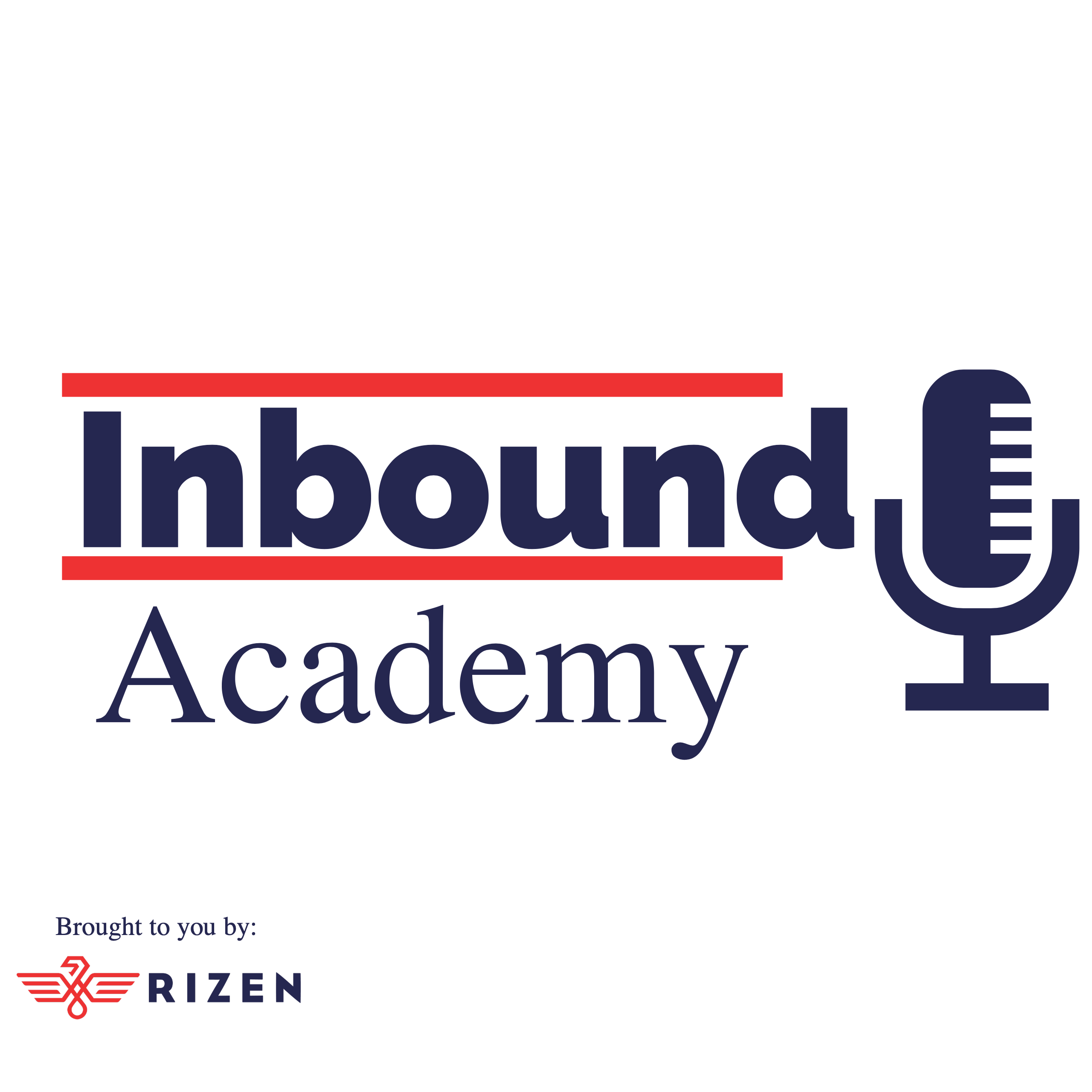Today on Inbound Academy we’re going to tell you the common principles every inbound company should adopt.
Episode Transcript
Jeff Lambert: Welcome to the show everybody. I'm your host, Jeff Lambert. If you've been listening to our previous episodes, we've been talking about how the inbound method can help you grow your business and build some really strong lasting relationships with your customers. Last episode, we discussed the inbound methodology, that framework that helps any business to be able to grow with their inbound plan. And today we're going to dive a little bit deeper into that and how you can implement those principles into your company. To talk more about that, I've invited back Rogelio Rodriguez, who's the CEO at Rizen. Rod, thanks for coming back.
Rod: Thanks for having me, Jeff.
Jeff: Well, let's talk about inbound a little bit more today to help our listeners to be able to figure out how they can further implement this methodology. As I've educated myself on inbound, I ran across a quote and it said, "to do inbound, you need to be inbound." What does that mean?
Rod: Sure. So I think it comes down to the principles of a business, right? And how inbound is this way to attract individuals to you in a holistic natural way by being who you truly are. To be able to attract similar and likeminded individuals to both your organization and your business. So I think you have to understand that inbound has to be in everything that you output. The content that you put out there and in the way that you deliver the content as well. And the way that you engage on social media. Try to be as authentic as you can in order to attract all like-minded individuals.
Jeff: So really...it has to be all encompassing?
Rod: Yeah. All encompassing.
Rod: I think a great resource to learn about how you can add inbound principles to your company or your organization is a great book by one of my mentors, Dan Tyre. It's called "Inbound Organization" and we actually have it here on the table so you can see it for our individual watchers. And listeners, we'll have a link so you can grab one.
Rod: But Dan Tyre and Todd Hockenberry, both great guys at Hubspot that developed this book, and they wrote this content in order to help individual organizations better adopt inbound principles.
Jeff: So Hubspot specifically recommends that every company or companies that adopt the inbound methodology, that they use specific principles to be able to align their company for best outcomes. What's the purpose of these principles?
Rod: So they serve as guidelines to every interaction that your team has with prospects, with customers, and with partners. They make sure that the company is being helpful, that it's human and it's holistic with your customers.
Jeff: That sounds simple enough. Why don't we talk about some of those principles? There's specific ones that they lay out and I'm going to go through each of them and ask you just to explain them a bit more into our listeners. We'll include a link for these, but I would encourage you to maybe write these down and think about how you can implement them at your own company. So let's start off with the first principle, "Standardize for Consistency." What is that all about?
Rod: Sure. So to put it as an example, right? If a customer asks three different employees at the same question, they should get the same answer. Everyone should know what your company does and why they do it, and be able to convey that to the customer.
Jeff: Yeah. Nobody likes to run around on a phone call where you're having to talk to three different people and they both have no idea what the other one's doing or saying.
Rod: Right! Or having to explain it again to the next rep, Right? There's plenty of companies that I've dealt with that have that problem.
Jeff: Oh yeah. I mean, that puts the relationship last, really.
Rod: Absolutely. Strained.
Jeff: So "Standardize for Consistency." That's the first one. The second one is "Contextualize for Relevance.? What does that refer to?
Rod: That's keeping track of all the data about interactions that you've gathered from a customer. In order to provide them the most relevant information that they may need at that point, at any given point. It prevents repetitiveness. When I initially interacted with Hubspot and I became a customer, my individual, a salesperson, gave me insight into what my contact record looked like. I saw over 80 interactions with the company that I had from calls and emails to the download of ebooks and resources. So they knew me, right? And they knew how they could help me best by my past interactions., So they could fulfill what I was looking for, fulfilling my needs at the time.
Jeff: Wow. I mean, do you have any suggestions for businesses on how they can catalog that information? Is it something you can do pen and paper? What would, what would be a good tool to help businesses start thinking about "okay, this is my potential customer and this is how they've interacted with me so far?"
Rod: There are several tools out there. I mean just to name a few Marketo, Pardot, our favorite obviously is Hubspot. We're Hubspot Partners. You can also do some of it with Google Analytics as well, and even the most, the more advanced version of Google Analytics which is 360, the offering from Google itself. But there's a plethora of tools.
Rod: But I think the whole idea would be first to adopt the inbound principles in order to do it in good way, in a holistic way, right? Maintaining that...aligning yourself with inbound principles will help you provide a more human approach because data can just be data and, and maybe make the experience for the customer less human, which is not what you want to try to do.
Jeff: So adopting that mindset is really important to start?
Rod: Yes, absolutely.
Jeff: Well, let's keep talking about that. So the next one that we have to talk about in terms of principles that businesses should adopt if they're going to take on inbound, the next one is "Optimize for Clarity." What does that refer to?
Rod: So we've got to be conscious of the strengths and weaknesses of each communication channel that you have. So you have to know how to best reach a customer on each platform. Instagram isn't great for sharing links. Twitter isn't great for long-form explanations. And you know, personal activities aren't the best for LinkedIn.
Jeff: And MySpace isn't good for anything, So, okay. That makes sense. You want to make sure that your content fits the channel that you're sharing it on.
Rod: Yes.
Jeff: That's simple enough and that's a good rule of thumb. Let's talk about the next one. "Personalize for Impact." What does that refer to?
Rod: So there's two pieces of information there. You know, it's keeping a detailed contact database in order to tailor each conversation you're having with the customer so that you're able to better understand the context of their "ask" or their problem.
Jeff: And that goes back to personalizing it, right?
Rod: Absolutely. It goes back to personalizing and then you have to make sure that the messaging always speaks directly to the person you're interacting with. You've got to treat them as an individual, not as a number.
Jeff: And that's, that's the difference between traditional and inbound really. You're not just a number, you're someone who knows what they want. You've done your research, "you're coming to me. I'm not trying to get to you" essentially.
Rod: Yes.
Jeff: It takes a bit of a shift in thinking and...Siri just tried to hop in on the conversation...sorry about that, everybody. So that leads us to our final principle that Hubspot outlines for a business that wants to adopt the inbound methodology, and that's "Empathize for Perspective." Can you unpack that?
Rod: Sure. So always remember that your customers are humans with emotions and you've got to keep their emotional state in mind when interacting or providing them guidance.
Jeff: How do I do that? If someone's on the line and they're just, you know, their package came and the product's broken and it's a birthday present for their kid and they're just lit up, they're upset. How do you even begin to emphasize with someone like that, do you think?
Rod: Yeah, I mean, I think the first step is listening, listening to them intently with an understanding of how you put yourself in their shoes. What would you want? What would be the best result for you in that case, in that scenario? Then you can come up with the best possible solution for them.
Jeff: And that comes back to the relationships?
Rod: Yes.
Jeff: So we have these five principles, and I'm just going to run through them again for our listeners: Standardize for Consistency, Contextualize for Relevance, Optimize for Clarity, Personalize for Impact, and Empathize for Perspective. If I adopt these five things, can I expect to start to see a shift in how my business operates?
Rod: Yes, absolutely. Absolutely. You'll see a shift even in the way you communicate internally with your own employees and associates, as well as how you communicate with vendors. The shift in the inbound methodology, or inbound itself, shifted our business greatly in the way that we apply everything throughout the organization.
Jeff: Well, I think this is a great starting point for listeners who are thinking about making the jump here. And Rod, thank you for sharing your expertise and your insight on this topic with everybody.
Rod: Absolutely.
Jeff: We'll see you on another episode.
Rod: All right. Thanks Jeff.
Jeff: Absolutely. So for our listeners, thank you so much for tuning in again to another episode. Remember, every weekday we have a new episode out for you, always focused on your business. If you want to find about Rizen a little bit more, or if you're thinking about partnering with a company to help you with your marketing efforts, check them out gorizen.com or follow them on social media. They're on Facebook, Instagram, and Twitter at Rizen_Inbound. That's one word, Rizen_Inbound. Thanks again for joining us for another episode, and we'll see you on the next one!
Want to stay in the know?
Join us, and get all the podcasts and more straight to your inbox.



.jpg?length=600&name=045%20-%20YouTube%20Cover%20Art%20(Video).jpg)


No Comments Yet
Let us know what you think